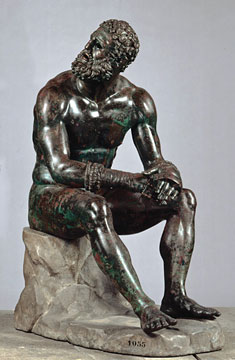Boxer at Rest Masterpiece of Ancient Bronze Sculpture on Special Loan to Metropolitan Museum
 Boxer at Rest, Greek, Hellenistic period, late 4th–2nd century B.C. Bronze with copper inlays.
Boxer at Rest, Greek, Hellenistic period, late 4th–2nd century B.C. Bronze with copper inlays.Photograph courtesy Soprintendenza Speciale per i Beni Archeologici di Roma – Museo Nazionale Romano – Palazzo Massimo alle Terme.
The celebrated over-life-size bronze statue Boxer at Rest Metropolitan Museum of Art in collaboration with the Italian Ministry of Foreign Affairs, the Ministero per i Beni e le Attività Culturali, and the Museo Nazionale Romano - Palazzo Massimo alle Terme.
“We are proud to host The Boxer at Rest, a special loan made possible by the Republic of Italy,” commented Thomas P. Campbell, Director and CEO of the Metropolitan Museum. “More than 2,000 years have passed since this virtuoso work of art was created, yet the powerful realism of its subject continues to captivate viewers today. The privilege to display this marvelous statue in the United States for the first time—and in the context of the Met’s exceptional collection—is a particular honor. We encourage our visitors not to miss this exciting opportunity.”
“Viewing one of the most stunning statues from antiquity is truly a singular opportunity,” said Italy’s Ambassador to the U.S., Claudio Bisogniero. “The Boxer is a masterpiece and its exhibition at the prestigious Met speaks volumes about the success of the Year of Italian Culture in the United States and how the more than 200 programmed events are contributing to expanding and deepening the relations between Italy and the U.S.”
The statue was excavated in Rome in 1885 on the south slope of the Quirinal Hill near the ancient Baths of Constantine, where it is thought to have been displayed. The sculpture was buried intentionally in late antiquity, possibly to preserve it against the barbarian invasions that ravaged Rome in the fifth century A.D. The broad-shouldered, lanky pugilist is shown seated, resting after a match. His gloves—which are highly detailed—identify him as a boxer. The athlete’s many head wounds are consistent with ancient boxing techniques, in which the head was the main target. The copper inlays, indicating blood, heighten the effect.
Scholars have long debated the date of the statue, placing it anywhere from the middle of the fourth century B.C. to the middle of the first century B.C.
Resources:
Also in this Issue:
- Rediscovering the Copper Treasures of The Titanic
- Copper Beckons in Armillary Spheres and Shultz Sundials
- History in Bronze: The Artwork of James E. Kelly
- Ginger Meek Allen: Metalsmith and Ringleader at LEDE Studio And Gallery
- Boxer at Rest Masterpiece of Ancient Bronze Sculpture on Special Loan to Metropolitan Museum
